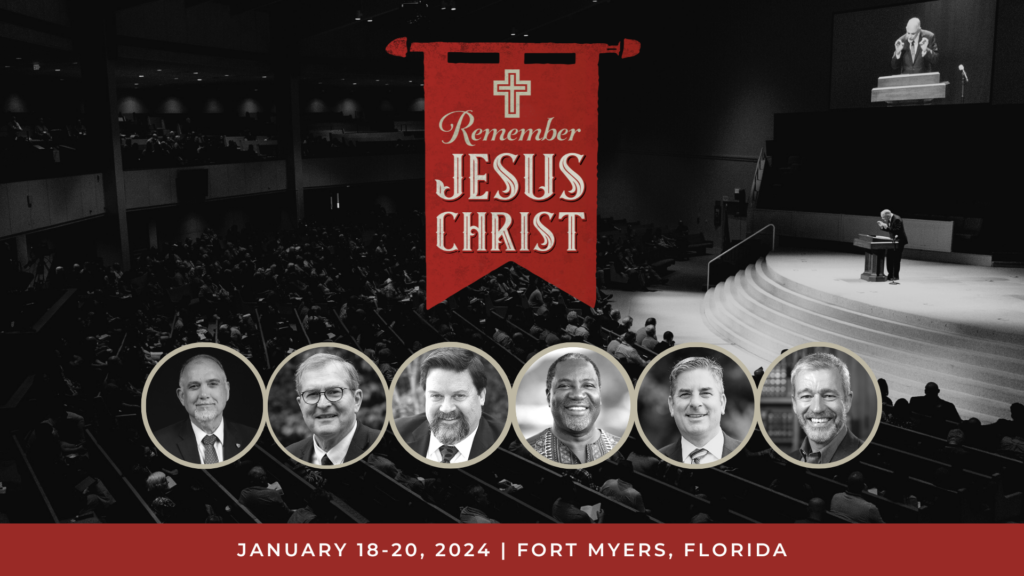This article is part 8 in a series by Tom Nettles on Remembering Jesus Christ. (Part 1, Part 2, Part 3, Part 4, Part 5, Part 6, Part 7).
Parts of this post were published on this site in 2016.
What we find on the pages of the New Testament concerning the true humanity of Christ and the concerns stated by the Apostles concerning those that deny it continued into the second and third centuries in a variety of forms of Gnosticism. Among other problems presented by Gnosticism, two embrace all the others. One, salvation comes through intuitive knowledge resident within certain spiritual persons. Two, the world of matter is intrinsically evil and was generated by an inferior deity. Implications include a denial of the final authority of the written word of the apostles and a denial of the full humanity of Christ, particularly the redemptive work accomplished in his flesh. In short, they denied all that Paul included in his admonition to “Remember Jesus Christ, risen from the dead, of a seed of David, according to my gospel” (2 Timothy 2:8).
In response to the insidious influence of this dualistic mysticism, the post-apostolic church developed the “rule of faith.” The various recensions of the rule of faith eventually were synthesized into a statement that most succinctly, clearly, and economically expressed universally received Christian truth known as the Apostle’s Creed. The finalized text of the Apostles’ Creed appeared in the work of Pirminius (d ca. 753) in A. D. 750. Pirminius used the succinct outline of biblical assertions to give instructions in Christian doctrine and morals to recently baptized Christians. Its twelve articles, according to pious legend, were given in order by the twelve apostles beginning with Peter and ending with Matthias. The creed is trinitarian.
I believe in God, the Father Almighty, Creator of Heaven and earth, And in Jesus Christ, his only begotten Son, our Lord: Who was conceived by the Holy Ghost, born of the Virgin Mary, suffered under Pontius Pilate; was crucified, dead and buried: He descended into hell: the third day he rose again from the dead: He ascended into heaven, and sits at the right hand of God the Father Almighty; From thence he shall come to judge the living and the dead. I believe in the Holy Spirit, the holy catholic church, the communion of saints, the forgiveness of sins, the resurrection of the flesh, the life eternal. Amen.
One can see the immediate significance, in light of the claims of Gnosticism, of phrases such as “the forgiveness of sins, the resurrection of the flesh.” What claims our energy presently are those early numbered 3 through 8, beginning “And in Jesus Christ,” and ending with “judge the living and dead.” Its affirmative sentences give a simple reflection of the facts of redemptive history as presented in biblical revelation. One can see in the focus on Christ’s incarnation and redemptive labors in the human nature as of central concern. As we found it in its incipient stage in the New Testament, Gnosticism in its denial of the true humanity of Christ had come to full flower.
Likewise, in the letters of Ignatius at the end of the first decade of the second century, we find a deep and clear commitment to Trinitarian doctrine, the real humanity as well as true divine sonship of Jesus Christ, the efficacy of his true bodily suffering and resurrection, the person of the Holy Spirit, and the necessity of unity of doctrine in the church. He warned the church at Trallia, to “partake only of Christian food, and keep away from every strange plant, which is heresy.” “There is only one physician,” Ignatius insisted, “who is both flesh and spirit, born and unborn, God in man, true life in death, both from Mary and from God, first subject to suffering and then beyond it, Jesus Christ our Lord.” [ Holmes, 88.]. Again, focused on the false teachers that presented Christ as a phantom-like creature, Ignatius proclaimed, “For our God, Jesus the Christ, was conceived by Mary according to God’s plan, both from the seed of David and of the Holy Spirit.” [Holmes, 92] In writing to the Trallians, Ignatius gives evidence of a confessional formula similar to this creed. His language shows that he understood the trickery of the verbal circumlocutions used by heretics in seeming to exalt Christ while in truth they denied both his true humanity and his eternal deity. Note how Ignatius seeks to cut through their façade. “Be deaf, therefore, whenever anyone speaks to you apart from Jesus Christ, who was of the family of David, who was the son of Mary, who really was born, who both ate and drank, who really was persecuted under Pontius Pilate, who really was crucified, and died while those in heaven and on earth and under the earth looked on; who, moreover, really was raised from the dead when his Father raised him up, who—his Father, that is, in the same way will likewise raise us up in Christ Jesus who believe in him, apart from whom we have no true life.” [Holmes, 100].
Throughout the writings of Justin Martyr (ca. 150) we find doctrinal assertions and phrases that show his familiarity with an early development of the “rule of faith” and his ability to apply those doctrinal principles in a variety of situations. For example, in his first Apology, Justin argued, “From all that has been said an intelligent man can understand why, through the power of the Word, in accordance with the will of God, the Father and Lord of all, he [the Word, or Son] was born as a man, was named Jesus, was crucified, died, rose again, and ascended into heaven.” [Apology, 46] Scattered throughout his Apology, we find these phrases “Jesus Christ our Savior was made flesh through the word of God, and took flesh and blood for out salvation.” Another says, “by the will of God he became man,… he came as a man among men.” In showing the truthfulness of the prophets, Justin narrated, “In these books, then, of the prophets we have found it predicted that Jesus our Christ would come, born of a virgin, growing up to manhood, and healing every disease and every sickness and raising the dead, and hated, and unrecognized and crucified, and dying and rising again and ascending into heaven, and both being and being called Son of God.” [Apology, 44] In his second Apology, Justin wrote, “For next to God [the Father], we worship and love the logos who is from the unbegotten and ineffable God, since also He became man for our sakes, that, becoming partaker of our sufferings, he might also bring us healing.”
So it is in the writings of Irenaeus (ca. 180), who in writing Against Heresies, said, “The church . . . received from the apostles and their disciples the faith in one God, the Father almighty, ‘who made heaven and earth, the sea, and all that in them is,’ and in one Christ Jesus, the Son of God, incarnate for our salvation, and in the Holy Ghost, who preached through the prophets the dispensations of God and the comings and the birth of the virgin and the passion and the resurrection from the dead, and the reception into heaven of the beloved, Christ Jesus our Lord, in the flesh, and his coming from heaven in the glory of the Father to sum up all things and to raise up all flesh of all mankind, that unto Christ Jesus our Lord and God our Saviour and King, according to the good pleasure of the invisible Father, ‘every knee should bow, of things in the heaven, and things on earth, and things under the earth, and that every tongue should confess’ him, and to execute just judgment upon all.” In describing how in the person of Christ we discover both god and man, Irenaeus wrote, “His word is out Lord Jesus Christ who in these last times became man among men, the he might unite the end with the beginning, that is, Man with God..” Later Irenaeus again summarized a discussion in saying “Our Lord Jesus Christ, the word of God, of his boundless love, became what we are that he might make us what he himself is.” Irenaeus’s description of Christ’s incarnation includes a description as to how each stage of human life was sanctified by him from infancy to adulthood. This led to his statement on recapitulation in which the unity of his person in both natures, God and man, is essential. “Therefore the Lord confesses himself to be the Son of man, restoring in himself that original man from whom is derived that part of creation which is born of woman; that as it was through a man that our race was overcome and went down to death, so through a victorious man we may rise up to life; and as through a man death won the prize of victory over us, so through a man we may win the prize of victory over death. … He has been united with his own handiwork and made man, capable of suffering. …. He existed always with the Father; but he was incarnate and made man.”
Tertullian (ca. 225) in his Prescriptions Against Heretics put much confidence in the reception of “The Rule of Faith” given, at least in its essential content, by Christ himself and proclaimed in the apostolic teaching, preserved in Scripture, and retained in the teaching of the apostolic churches. He wavered not in his conviction that “Christ laid down one definite system of truth which the world must believe without qualification, and which we must seek precisely in order to believe it when we find it.” He went on to report that the Rule of Faith is “that by which we believe that there is but one God, who is none other than the Creator of the world, who produced everything from nothing through his Word, sent forth before all things; that this Word is called his Son, and in the name of God was seen in divers ways by the patriarchs, was ever heard in the prophets and finally was brought down by the Spirit and Power of God the Father into the Virgin Mary, was made flesh in her womb, was born of her and lived as Jesus Christ; who thereafter proclaimed a new law and a new promise of the kingdom of heaven, worked miracles, was crucified, on the third day rose again, was caught up into heaven and sat down at the right hand of the Father; that he sent in his place the power of the Holy Spirit to guide believers; that he will come with glory to take the saints up into the fruition of the life eternal and the heavenly promises and to judge the wicked to everlasting fire, after the resurrection of both good and evil with restoration of their flesh.”
Augustine (ca. 421) used the order of the creed in writing his Enchiridion probably alternating between the version of Hippo and the version of Milan for precise wording. The Creed served as the basis for several other writings and sermons. He pointed to the Lord’s Prayer and “the Creed” as easily memorized and constituting the sum of faith, hope and love. “Because the human race was oppressed with great misery because of sin, and stood in need of the divine mercy, the prophet foretold the time of God’s grace and said Then everyone who calls on the name of the Lord shall be saved (Jl 2:32). That is the reason for the prayer. But when the apostle quoted this testimony of the prophet in order actually to proclaim God’s grace, he immediately added But how are they to call on one in whom they have not believed? (Rom 10:14). That is why we have the Creed.”
Having its basis in the biblical revelation of the Trinity and the focus on the work of Christ in his incarnation, these teachers shared the truth of the apostolic revelation that had Christ not been truly like us in all things pertaining to our humanity, the corrupting power of original sin excepted, he could in no sense be a redeemer of this race. While Gnostics such as Valentinus sought to deny the true humanity of Christ and Marcion sought to destroy the unity between the God of creation and the God of redemption, biblically sound Christian teachers found these synthesized assertions helpful in exposing the faulty steps of heresy. They focused on the unity of Scripture, the unity of God, the truth and necessity of the incarnation, the reality of Christ’s fully redemptive death and resurrection accomplished in his human nature in indivisible unity with his eternal sonship. The presence of the Holy Spirit, the unity of the church, the resurrection of the just and the unjust, and the reality of eternal states of each gave biblical symmetry to the whole of the truths confessed. In order to defend, teach, and confess the truth as well as test its existence in others this creed served the cause of orthodoxy well and still stands as one of the truly ecumenical expressions of biblical faith.
Those who saw the “Rule of Faith” as faithful to Scripture, who served in the development of this rule into the Apostles’ Creed did so in obedience to the Pauline admonition, “Remember Jesus Christ, risen from the dead, of a seed of David, according to my gospel.”
Join us at the 2024 National Founders Conference on January 18-20 as we consider what it means to “Remember Jesus Christ” under the teaching of Tom Ascol, Joel Beeke, Paul Washer, Phil Johnson, Conrad Mbewe and Travis Allen.






















